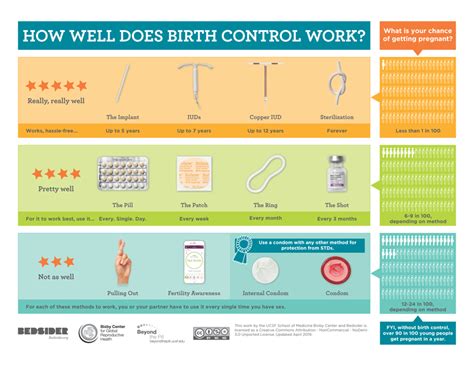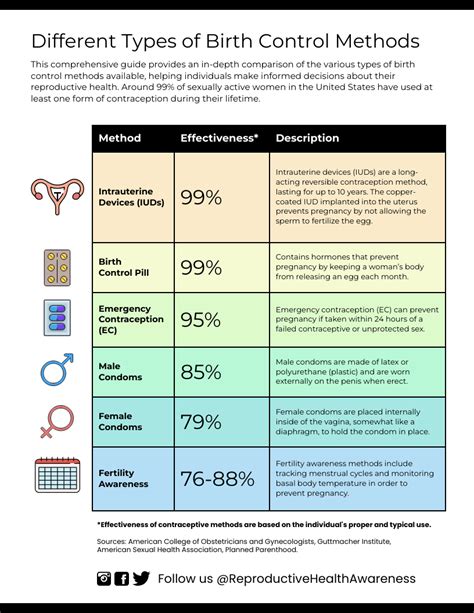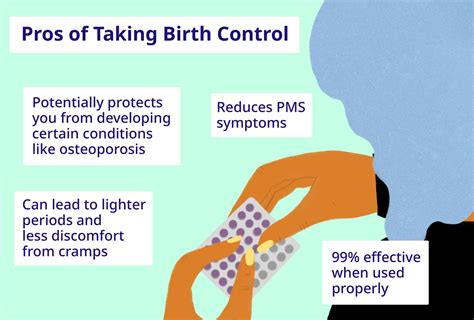Intro
Compare birth control methods with our effectiveness chart, featuring IUDs, pills, and condoms, to determine the best contraception option for you, considering factors like failure rates, user compliance, and hormonal influences.
The effectiveness of birth control methods is a crucial factor for individuals and couples seeking to prevent unplanned pregnancies. With numerous options available, understanding the efficacy of each method can help inform decision-making. Birth control effectiveness is typically measured by the failure rate, which is the number of pregnancies that occur per 100 women using a particular method over a one-year period. In this article, we will delve into the world of birth control, exploring the various methods, their effectiveness, and what factors can influence their success.
When considering birth control, it's essential to recognize that no method is 100% effective, although some come close. The effectiveness of a birth control method can depend on various factors, including how well the user follows instructions, the quality of the method, and individual biological factors. For instance, barrier methods like condoms require consistent and correct use to be effective, whereas hormonal methods like the pill or implant can be more forgiving if used as directed. Understanding these nuances is vital for making informed decisions about reproductive health.
The landscape of birth control is diverse, ranging from barrier methods and hormonal contraceptives to permanent sterilization and natural family planning. Each method has its unique benefits, drawbacks, and level of effectiveness. For example, the intrauterine device (IUD) is known for its high effectiveness and long-lasting protection, while condoms offer the added benefit of protecting against sexually transmitted infections (STIs). The choice of birth control can significantly impact an individual's or couple's quality of life, affecting not only their reproductive health but also their physical and emotional well-being.
Understanding Birth Control Effectiveness

To navigate the complex world of birth control, it's helpful to have a clear understanding of how effectiveness is measured and what factors can influence it. Effectiveness is often categorized into typical use and perfect use scenarios. Typical use refers to how effective a method is in real-world conditions, where users may make mistakes or not use the method consistently. Perfect use, on the other hand, assumes that the method is used correctly and consistently, as instructed. This distinction is crucial because it reflects the potential for human error and the importance of proper use in achieving the highest level of effectiveness.
Factors Influencing Effectiveness
Several factors can influence the effectiveness of birth control, including user compliance, the presence of any underlying medical conditions, and the interaction with other medications. For hormonal contraceptives, factors such as weight, smoking status, and certain genetic predispositions can affect how well the body absorbs and processes the hormones, thereby impacting the method's efficacy. Additionally, the quality of the product itself, such as the manufacturing standards for condoms or the potency of spermicides, can play a significant role in determining effectiveness.Birth Control Methods and Their Effectiveness

The array of birth control options available can be overwhelming, but understanding the effectiveness of each can help narrow down the choices. Here are some of the most common methods, along with their typical and perfect use effectiveness rates:
- Combined Oral Contraceptives (COCs): These are known for their high effectiveness when used perfectly (99.7%) but have a slightly lower typical use effectiveness (91%).
- Progestin-only Pill (POP): Similar to COCs, the progestin-only pill has a high perfect use effectiveness (99.7%) and a typical use effectiveness of about 91%.
- Intrauterine Device (IUD): IUDs, whether hormonal or copper, are among the most effective forms of reversible birth control, with both typical and perfect use effectiveness rates of over 99%.
- Condoms: Male condoms have a perfect use effectiveness of about 98% but a typical use effectiveness of 87%. Female condoms are less effective, with a typical use effectiveness of about 79%.
- Implant: The contraceptive implant, which releases hormones into the body, has a perfect and typical use effectiveness of over 99%.
- Patch and Ring: The transdermal patch and vaginal ring, both hormonal methods, have effectiveness rates similar to those of oral contraceptives, with perfect use effectiveness of 99.7% and typical use effectiveness of about 91%.
- Diaphragm and Cervical Cap: These barrier methods have a perfect use effectiveness of about 94% but a typical use effectiveness that can range from 88% to 74%, respectively.
- Spermicides: Used alone, spermicides have one of the lowest effectiveness rates, with a typical use effectiveness of about 72%.
Comparing Effectiveness Across Methods
When comparing the effectiveness of different birth control methods, it's essential to consider not only the numerical rates but also the context in which they are used. For instance, methods that require daily action, like the pill, can be less effective in typical use scenarios due to the potential for missed doses. On the other hand, long-acting reversible contraceptives (LARCs) like the IUD and implant, which require minimal user action after insertion, tend to have higher typical use effectiveness rates.Making an Informed Decision

Choosing the right birth control method is a personal decision that depends on various factors, including lifestyle, health status, and personal preferences. It's crucial to weigh the benefits and drawbacks of each method, considering factors such as ease of use, potential side effects, and the level of effectiveness. Consulting with a healthcare provider can provide valuable insights and help individuals make informed decisions that align with their reproductive goals and overall health.
Considering Lifestyle and Health Factors
Lifestyle factors, such as travel frequency, sexual activity level, and the ability to adhere to a daily regimen, can significantly impact the choice of birth control. Additionally, health factors, including any pre-existing medical conditions, can influence the suitability of certain methods. For example, individuals with a history of blood clots may need to avoid certain hormonal contraceptives. Understanding these interactions is vital for selecting a method that is both effective and safe.Future of Birth Control

The landscape of birth control is continuously evolving, with research focusing on developing methods that are more effective, safer, and more convenient. Advances in technology and a deeper understanding of human biology are leading to the creation of new contraceptives that cater to diverse needs. For instance, efforts to develop a male contraceptive pill or injection are underway, aiming to provide men with more options for reproductive control. The future of birth control holds promise for improved effectiveness, increased accessibility, and enhanced user experiences.
Emerging Trends and Technologies
Emerging trends in birth control include the development of non-hormonal contraceptives, which could provide alternatives for individuals who experience adverse effects from hormonal methods. Additionally, digital health technologies, such as apps and wearable devices, are being explored for their potential to enhance contraceptive use and effectiveness. These innovations have the potential to revolutionize how individuals approach birth control, making it more personalized, accessible, and effective.Conclusion and Next Steps

In conclusion, the effectiveness of birth control methods is a multifaceted issue that depends on a variety of factors, including the type of method, user compliance, and individual health factors. By understanding these dynamics and considering personal preferences and health status, individuals can make informed decisions about their reproductive health. As research continues to advance and new technologies emerge, the future of birth control looks promising, with the potential for more effective, convenient, and personalized options.
Final Thoughts
As individuals navigate the complex world of birth control, it's essential to stay informed, consider all available options, and consult with healthcare professionals. The journey to finding the right birth control method is unique to each person, and what works for one individual may not work for another. By prioritizing reproductive health and staying open to the evolving landscape of birth control, individuals can take control of their bodies and their futures.What is the most effective form of birth control?
+The most effective forms of birth control are generally considered to be long-acting reversible contraceptives (LARCs), such as the intrauterine device (IUD) and the implant, which have effectiveness rates of over 99%.
How do I choose the right birth control method for me?
+Choosing the right birth control method involves considering factors such as your health status, lifestyle, and personal preferences. It's recommended to consult with a healthcare provider to discuss your options and determine the best method for your needs.
Can I use multiple birth control methods at the same time?
+Yes, using multiple birth control methods, such as combining a hormonal method with a barrier method, can provide additional protection against pregnancy and, in some cases, sexually transmitted infections. However, it's essential to discuss this approach with a healthcare provider to ensure safety and effectiveness.
We invite you to share your thoughts and experiences with birth control in the comments below. Your insights can help others make informed decisions about their reproductive health. Additionally, if you found this article informative, please consider sharing it with others who may benefit from this information. Together, we can promote a better understanding of birth control effectiveness and support individuals in making empowered choices about their health and well-being.
